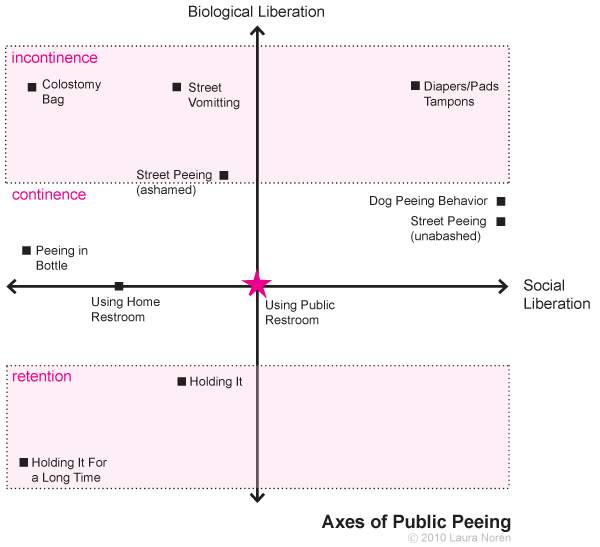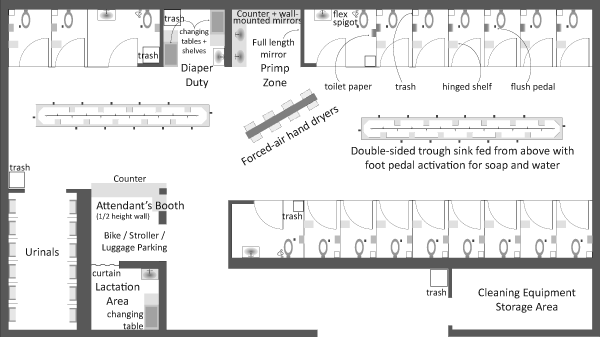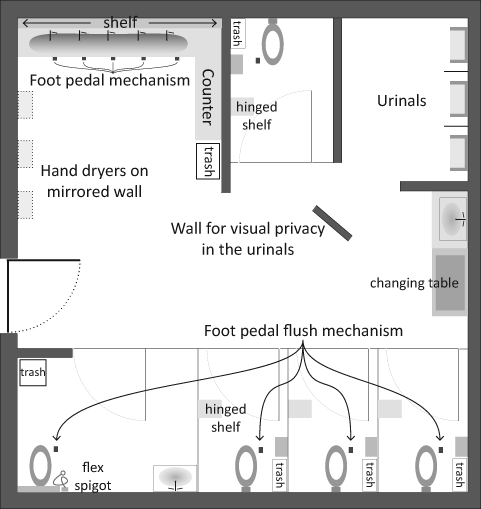
What works
This was something I used to help me think through the two main axes that determine peeing behavior – biological and social control. Urination is a biological function that has been subjected to a great degree of social control. Unfortunately, urban design has not kept pace with the demand for clean, easily accessible public restrooms for humans. And there has been no attempt to create any kind of system to deal with canine urine. In most cities it is illegal for humans to pee in public but both legal and widely accepted for dogs to pee where ever they like (in New York, they cannot pee on the grass in parks).
What worked about this as a graphic is that it helped me sort out how I was thinking about the problem of access to the city when the bladder is a leash. I couldn’t quite sort out how to think about what it means that some public peeing is acceptable even though it is mostly completely unacceptable. One of the odd side effects of the introduction of the new TSA pat down procedures is that it revealed just how many people struggle with incontinence, either needing to urinate frequently or needing to wear diapers (or both). I was aware of those issues before the TSA started sticking their hands in private places, but I wasn’t sure how to simultaneously think about adult diapers, dogs peeing on the street, and taxi/truck drivers peeing in jugs while still in their cabs. Where social control is very strong – as it is in the case of urination – it can almost trump biological needs, especially if the biological needs offer a level of control. Clearly, not all peeing can be put under biological control, but a good deal of it can. I stuck vomiting on the map since that is harder to control than peeing and it was useful to include a biological drive that has not been so easy to tame with the civilizing process.
What needs work
The glaring problem here is the ‘who cares’ problem. Very few care about the axes of social and biological control, though there are a few other case types that could use these axes (burping/farting, posture, chewing, etc). But the re-use of this exact same set of axes is not the point. Nor do I particularly care if you are interested in public peeing.
I introduced this graphic because it was helpful to me in thinking through the analysis of a multi-faceted problem. All social science problems are multi-faceted. Setting up four quadrants as a field is superior to setting up four quadrants in a two by two table, though that is a variant of this approach. I find that approach is too reductive, forcing things to be lumped together that really are not all that similar. In this case, I was able to add more nuance by leaving the mid-section of the biological control vector unmarked while I singled out incontinence and retention (where retention is beyond routine continence).
This approach to thinking through forces you to come up with the two critical dimensions that organize both the empirical information you’ve gathered and the theoretical arc you would like to follow. If you are skilled, you could add a third dimension. A 2×2 table only gives you boxes, not spectrums. What’s more, the spectrum approach is more open, allowing the addition of further segmentation or layering which is not as easy to achieve in a 2×2 table.


